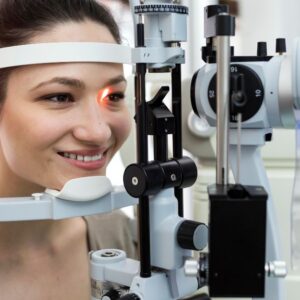What Is Astigmatism?
Astigmatism is a type of refractive error that occurs when the front surface of the eye (the cornea) or the lens inside the eye is irregularly shaped. This irregular shape causes light to be focused incorrectly on the retina, which leads to blurry or distorted vision.
Astigmatism is common and can occur with other refractive errors, such as nearsightedness or farsightedness.
Symptoms of astigmatism include difficulty seeing fine details, eye strain, headaches, and squinting. Astigmatism can be corrected with contact lenses, eyeglasses, or refractive surgery.
Types of Contact Lenses for Astigmatism
Several types of contact lenses can be used to correct astigmatism, including:
- Toric lenses are specially designed to correct astigmatism and have different powers in different lens meridians. They are typically made of soft material and are available in daily, weekly, or monthly disposable options.
- Hybrid lenses: These lenses have a hard center that corrects astigmatism and a soft skirt that conforms to the shape of the eye. They are a good option for people who have difficulty getting used to traditional soft toric lenses.
- Gas permeable lenses: These lenses are made of a hard, rigid material that corrects astigmatism by reshaping the cornea. They are a good option for people with a high degree of astigmatism.
- Orthokeratology (Ortho-K) lenses: These specially designed hard contact lenses are worn overnight to reshape the cornea and correct astigmatism. They are a non-surgical alternative to laser refractive surgery and are removed daily.
It’s best to consult an eye specialist to determine the best type of contact lens for your specific needs.
Benefits of Contact Lenses For Astigmatism
Wearing contact lenses for astigmatism can offer several benefits, including:
- Improved vision: Contact lenses can provide a clear, crisp vision for people with astigmatism by correcting the irregular shape of the cornea or lens.
- Increased freedom: Contact lenses allow for a wide field of vision and do not require the wearer to look over the top or through the sides of the glasses. This makes activities such as sports and other physical activities more comfortable.
- Greater appearance: Contact lenses are worn inside the eye, so they are not visible outside. This can be beneficial for people who are self-conscious about their appearance.
- Convenience: Contact lenses are easy to care for and can be worn for extended periods, making them a convenient option for people with busy lifestyles.
- Flexibility: There are different types of contact lenses for astigmatism available, including daily, weekly, and monthly disposable options, as well as hybrid and orthokeratology lenses. This allows people to choose the lens best fits their lifestyle and preferences.
- Reduced glare and halos: Contact lenses can reduce the glare and halos that often accompany glasses, making night driving and other low-light activities safer.
Contact lenses can offer many benefits; following the proper care and hygiene guidelines is vital to maintain healthy eyes. It’s essential to consult your eye doctor to determine if contact lenses are the best option for you and follow their instructions for proper care and use.
How to Fit Contact Lenses For Astigmatism
Fitting contact lenses for astigmatism typically involves the following steps:
- Eye examination: An eye doctor will perform a comprehensive eye examination to determine the degree and type of astigmatism you have. They will also measure the size and shape of your cornea, which is necessary to fit contact lenses properly.
- Lens selection: Based on the eye examination results, the eye doctor will select the appropriate type and power of contact lenses for your astigmatism.
- Trial fitting: The eye doctor will then fit you with trial lenses to ensure the correct fit and assess your vision with the lenses. This will also help the eye care professional determine the proper lens size and material that best fits your eyes.
- Training and instructions: The eye specialist will teach you how to properly insert, remove, and care for your contact lenses. They will also provide instructions on handling and cleaning the lenses and how often to replace them.
- Follow-up: The eye specialist will schedule a follow-up appointment to check the fit and vision of the contact lenses and make any necessary adjustments. It’s essential to return for follow-up visits as scheduled to ensure that the contact lenses continue to fit correctly and that your vision is stable.
The fitting process for contact lenses can vary depending on the type and brand of lens, as well as the individual’s needs and preferences. It’s best to consult with an eye doctor to determine the best approach for your specific situation.
How to Maintain Contact Lens For Astigmatism?
Here are some best practices for wearing and maintaining contact lenses for astigmatism:
- Follow the recommended wearing schedule: Always wear the lenses for the recommended time and replace them as directed by your eye care professional.
- Clean and disinfect the lenses properly: Follow the instructions provided by your eye care professional for cleaning and disinfecting your contact lenses. This will help to reduce the risk of infection.
- Handle the lenses carefully: Be sure to handle them carefully when inserting and removing them, to avoid damaging them.
- Avoid exposing the lenses to water: Never wear the lenses while swimming or showering, as water can contain microorganisms that can cause eye infections.
- Never sleep with contact lenses: Sleeping with contact lenses increases the risk of corneal infection.
- Keep your eyes lubricated: Use rewetting drops or artificial tears as directed by your eye care professional to keep your eyes lubricated and comfortable while wearing the lenses.
- Visit your eye care professional regularly: Regular check-ups and follow-up appointments will ensure that your contact lenses continue to fit correctly and that your vision is stable.
- Be aware of signs of trouble: If you experience redness, pain, excessive tearing, or other symptoms, remove the lenses immediately and contact your eye care professional.
It’s important to remember that contact lenses are medical devices, and it’s essential to follow the instructions provided by your eye doctor to ensure proper use and minimize the risk of complications.
It’s also essential to keep the follow-up appointments with the eye specialist to ensure the lenses fit well and your vision is stable.
Purchasing Contact Lenses For Astigmatism
Before purchasing contact lenses for astigmatism, there are several things you should consider:
- Consult an eye doctor: It’s essential to consult an eye doctor to determine the best contact lens for your specific needs. They will perform a comprehensive eye examination and measure the size and shape of your cornea to fit the contact lenses properly.
- Consider the cost: Contact lenses can be more expensive than eyeglasses, especially if you choose a brand not covered by your insurance. Be sure to consider the cost of the lenses, as well as the cost of cleaning and disinfecting solutions.
- Consider your lifestyle: Different types of contact lenses have different wearing schedules, so be sure to choose a lens that fits your lifestyle. For example, choose a daily disposable lens if you have a busy schedule and need a lens that you can wear for extended periods.
- Be aware of the risks: Contact lenses can cause complications such as infection, irritation, and corneal damage if not worn and appropriately maintained. Be sure to discuss the potential risks with your eye specialist and follow their instructions for proper care and use.
- Be aware of your coverage: Some insurance plans may not cover contact lenses or may only cover specific types or brands. Check with your insurance provider to understand your coverage before making a purchase.
- Understand the return policy: Before purchasing any contact lenses, understand the return policy if the lens doesn’t fit or causes discomfort.
- Consider the source of purchase: It’s essential only to purchase contact lenses from reputable sources. Avoid purchasing contact lenses from unregulated vendors, such as street vendors, flea markets, or the Internet, as these may be counterfeit or expired products.
How Do Contacts for Astigmatism Correct Vision?
Toric contact lenses are specially designed to correct astigmatism by adjusting the shape of the eye’s front surface to match the shape of the patient’s cornea. These lenses have different powers in different meridians, which helps to align the light that enters the eye and focus it correctly on the retina.
The lens is divided into two main meridians, the vertical and the horizontal. The vertical meridian is the part of the lens that corrects the nearsighted or farsighted portion of astigmatism, while the horizontal meridian is the part that corrects astigmatism itself.
The toric lens is designed to rotate on the eye so that the lens’s horizontal meridian aligns with the cornea’s horizontal meridian, thus correcting astigmatism.
Toric contact lenses are available in both soft and rigid gas-permeable materials. Soft toric lenses are more comfortable and easier to handle but may move around on the eye more than rigid lenses. Rigid lenses tend to stay in place better, but they may be less comfortable and take longer to get used to.
Summary
Toric contact lenses correct astigmatism by adjusting the shape of the eye’s front surface to match the shape of the patient’s cornea. They align the light that enters the eye and focuses it correctly on the retina. They are divided into two main meridians, the vertical and the horizontal. The toric lens is designed to rotate on the eye so that the lens’s horizontal meridian aligns with the cornea’s horizontal meridian.






